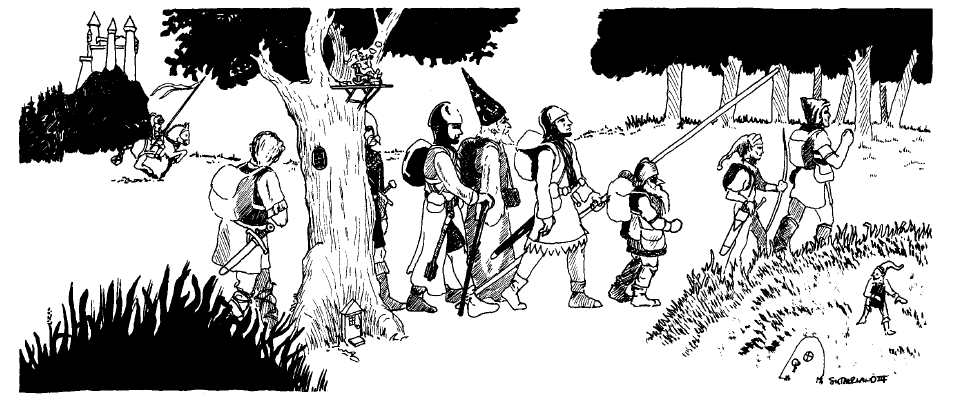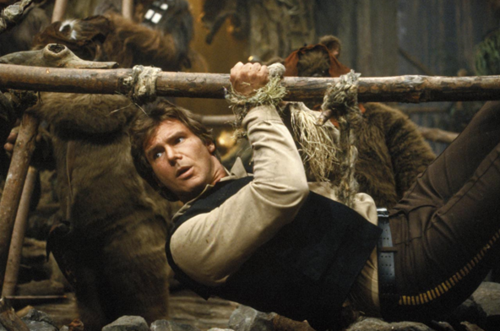 |
| Sutherland illo from B1 In Search of the Unknown |
Q1: What is the function of a 10' pole?
A1: The main idea is to find the traps before the traps find you. I've seen two main methods for how to make this happen. The first is to post one or two guys at the head of the marching order. As the party moves down corridors at dungeon exploration speed, these guys sweep their poles back and forth, tapping the floors. The goal is to reveal hidden tripwires, pressure plates, etc., by triggering them while at hopefully a safe distance. In a universe where even some lifeforms evolve to fit the 10' graph paper grid, it's nice to be able to say that you are, at worst, at the very edge of the 10' effect. I once met a guy who, to make assurance doubly sure, always got custom-made 11' poles.
For this sort of duty you probably want lightly armored and unencumbered characters, thieves or henchweenies in leather armor. You need these guys to be able to drop their poles and clear the way for the fighters to engage with wandering monsters. In an ideal situation you don't want the party tanks on this duty, because then you give the DM an opportunity to be a dick about the time needed to drop the poles, draw weapons and ready shields.
The other key thing you can do with a 10' pole is to poke stuff. Specific dungeon features can be probed. Is that green stain just dungeon dressing or actual green slime? Is that an ugly statue or a gargoyle playing possum? Exactly what sort of horrible vermin is hiding in that trash in the corner? Obviously the DM isn't going to play ball every time (e.g. this particular gargoyle isn't ticklish), but it's safer than daring the bard to touch the spooky thing.
Finally, some DMs will allow the 10' pole to bear some weight or be used to apply leverage. I've seen them used to pole-vault over walls and across gaps, usually by high Dex thieves And I've at least heard players discuss hauling a goblin prisoner around like Han Solo captured by ewoks. (This scenario never actually happened, by the way. The players just slit the goblin's throat. As always.) You might want to talk to your DM before trying this sort of nonsense, as it relies on a specific model of the material properties of the pole.
Q2: Does using a 10' pole in these ways actually work?
Personally, I think there are plenty of situations where the 10' pole treatment ought to just plain work, no die throw. If the guys in the front rank are sweeping the hallway, they should set off trip wires and locate simple pit type traps with no real difficulty. A poke in some acid or a viper nest ought to provoke a useful result. Only for more complicated situations would I throw dice, like finding out if contact is made with a small pressure point. In such a scenario whatever chance there is of a PC setting off the trap would be the roll I would use to see if it was set off before the PCs got there. On the other hand, if the party is actively tapping every surface with a wooden pole, they might make extra noise and take extra time. Maybe throw an extra random monster check every once in a while to compensate.
Note that I don't believe that a 10' pole would make a good implement for vaulting, but I'd give anyone a 2 in 6 chance to do just about anything under the right circumstances. The house wins in the long run under those odds, but I love to see players attempt the improbable.
Q3: Why not just use a spear or quarterstaff?
I hear this one again and again when people are buying equipment. First, there's the economic factor. In OD&D a 10' pole and a spear both cost 1 gold each, but later editions got smarter. In BX a spear is 3gp, a quarterstaff 2gp, and a ten foot pole is 1gp. In the AD&D1 Players Handbook the cost difference between spear and pole is one gold piece versus only 3cp. LotFP shows a similar gap. I've heard players blithely remark that they can just go to the woods and cut their own pole, but I've never seen anyone do it. Which is probably good, since someone with a fancy title and oathsworn knights and catapults probably owns that tree.
Then there's the length issue. Per the AD&D1 PHB a quarterstaff is 6 to 8 feet long. A spear can vary from 5' to 13' or more. You probably don't want to argue about the length of your spear after the DM tells you a 10' diameter puff of gas shoots out of a hidden nozzle.
More importantly, if you want to stick one of your weapons into a pool of mysterious liquid, I say bring it on. I'd be happy to relieve you of that spearhead. Or if you want to sweep hallways with a metal blade I'll be thrilled to blunt its point or let it make some extra clangy noises. Maybe it can even kick up a couple sparks in a room with an excess of flammable gas. Sounds like my idea of a good time.
Then there's the length issue. Per the AD&D1 PHB a quarterstaff is 6 to 8 feet long. A spear can vary from 5' to 13' or more. You probably don't want to argue about the length of your spear after the DM tells you a 10' diameter puff of gas shoots out of a hidden nozzle.
 |
| more Sutherland, more B1 |
Q4: Any downsides to using 10' poles?
I think it would be really interesting to purchase a ten foot length of PVC pipe and try to go about my day hauling that sucker around. I imagine fitting through doors, on elevators, tight turns on winding staircases, etc., would be a gigantic pain in the ass. Yet another reason to leave the ten foot polling to the henchweenies.
Also, unlike spears and staffs, the 10 foot pole is clearly not intended to be useful as a weapon.
I think it would be really interesting to purchase a ten foot length of PVC pipe and try to go about my day hauling that sucker around. I imagine fitting through doors, on elevators, tight turns on winding staircases, etc., would be a gigantic pain in the ass. Yet another reason to leave the ten foot polling to the henchweenies.
Also, unlike spears and staffs, the 10 foot pole is clearly not intended to be useful as a weapon.























































































































.jpg)

































.png)








.jpg)














No comments:
Post a Comment